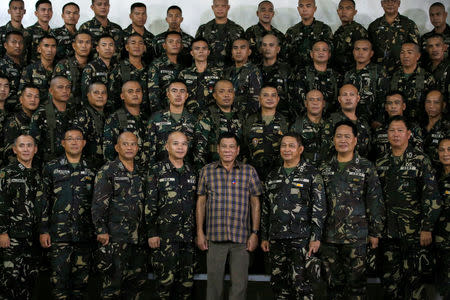In a Powerpoint, Philippine police detail body count in drug war
By Manuel Mogato and Andrew R.C. Marshall MANILA/BANGKOK (Reuters) - A Philippine police report on an anti-drugs campaign that has killed 1,900 people in seven weeks shows an openness and even pride in an escalating body count that has horrified rights activists and unsettled allies such as the United States. The bloody campaign, launched when President Rodrigo Duterte took office, has reduced crime and won public support, said the report presented to a Senate hearing in Manila on Tuesday. National police chief Ronald dela Rosa read out from the report, accompanied by a Powerpoint presentation with charts and data, at the hearing. He said a total of 756 people were killed by police during a seven-week operation beginning July 1 that has been dubbed "Double Barrel". An additional 1,160 people were killed by what police have suggested are vigilantes. Most victims were shot. "The government's war on drugs is highly appreciated and supported by the public," the report said. However, dela Rosa said there was no declared policy to kill drug users and pushers. One U.S. expert said that tolerance for such a large body count was inconceivable in the West, where all police killings are intensely scrutinized. "This is the most heavy-handed kind of street-side justice - and they expect to be praised for it," said Eugene O'Donnell, a professor at John Jay College of Criminal Justice in New York and a former police officer and prosecutor. Police should only use deadly force as a last resort to defend themselves or others and "never as a punishment", he said. "Obviously, the ethical implications are extraordinary," he added. Duterte, nicknamed "the Punisher", won the presidency on a platform of wiping out drugs, and had warned traffickers before he took office to reform or risk death. A spokesman for the U.S. State Department said on Monday it was "deeply concerned" by the killings and urged Duterte's government to abide by human rights norms. New York-based Human Rights Watch has condemned the "shocking human toll" and accused Duterte of inciting violence and "steamrolling the rule of law". "SIGNIFICANT DECREASE" The Philippines police report credits the anti-drugs campaign for a "significant decrease" in overall crime, noting that the total number of serious offences was 31 percent lower in July 2016 than July 2015. But a further breakdown of the figures showed that the number of murders and homicides had increased by 56 percent. Experts said the decrease in serious crime could be a genuine drop caused by an increased police presence on the streets; or it could be that fewer instances of crimes such as theft are being reported because police are so preoccupied with anti-drug operations. More than 100 of the corpses were hog-tied or bound with duct tape, or found with pieces of cardboard bearing messages such as "I'm a pusher. Don't emulate me." According to the report, a total of 309 of the killings were carried out by what the police call MRCs, or motorbike-riding criminals. There has been speculation in the local media that some of the killings were carried out by corrupt police officers who were wiping out drug peddlers to avoid exposure. Senator Leila de Lima, a staunch critic of the president, led the two-day inquiry. Many of her fellow senators expressed support for the police crackdown but concern for the killings. Among them was boxing legend Manny Pacquiao, who was elected to the Senate in the May general election. After the hearing, dela Rosa was mobbed by people demanding selfies, while supporters chanting his nickname "Bato", or rock. Even as the death toll rose, a July poll by Pulse Asia put Duterte's approval rating at 91 percent. "Do not kill if you are not in danger of losing your life," Duterte told police officers in a speech last week. "But if the resistance is violent, thereby placing your life in jeopardy, shoot and shoot him dead. Can I be more clearer than that?" (Additional reporting by Eric M. Johnson in Seattle and Karen Lema in Manila; Editing by Raju Gopalakrishnan)


